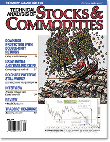Letters To The Editor
July 2009 Letters To The Editor
The editors of S&C invite readers to submit their opinions and information on subjects relating to technical analysis and this magazine. This column is our means of communication with our readers. Is there something you would like to know more (or less) about? Tell us about it. Without a source of new ideas and subjects coming from our readers, this magazine would not exist.
Address your correspondence to: Editor, Stocks & Commodities, 4757 California Ave. SW, Seattle, WA 98116-4499, or E-mail to editor@traders.com. All letters become the property of Technical Analysis, Inc. Letter-writers must include their full name and address for verification. Letters may be edited for length or clarity. The opinions expressed in this column do not necessarily represent those of the magazine. —Editor
TRUE RANGE, REWARD/RISK, AND POSITION SIZE
 Editor,
Editor,
In the May 2009 issue of S&C is an article by Alan Binder, “True Range, Reward/Risk, And Position Size.” I have a question about the calculation of the values in cells D16, D17, and D18 of the input sheet. Most of the information is straightforward enough, but that calculation is a mystery. Could the author illuminate?
—Joe Ziomek
Durango, CO
Alan Binder replies:
The numbers refer to the number of standard deviations for the indicated certainty values. Please refer to the Stocks & Commodities article, “Value At Risk And Technical Analysis” by Luis Ballesca-Loyo (August 1999, Volume 17: Number 8).
TRUE RANGE, REWARD/RISK, AND POSITION SIZE
Editor,
I have a question for Alan Binder regarding his May 2009 article in S&C, “True Range, Reward/Risk, And Position Size.”
I would like to adapt his calculations for use on the emini Russell 2000. I am working on a three-minute chart of this contract. I took the high, low, and close of one bar every nine minutes on one whole session (8:30 am to 4:00 pm), which gave me 50 data series (instead of the 30 days’ data used in his article). On the first spreadsheet example for true range mean and standard deviation, I did not have any problems, but the problems started when I had to begin a second Excel spreadsheet for the reward/risk and position size calculations.
I hope you can direct this question to the author.
—Vartan Agopyan
Alan Binder replies:
I have not tried this method on a futures contract or on such a small time unit. I suspect that this method might not work on a short-term basis. In addition, consider the volume for this contract. For stocks, I would not choose a volume of less than 200,000 shares per day.
ERRATA: FUTURES FOR YOU
 Editor,
Editor,
Can someone purchase back copies of your magazine, or do you offer Pdf copies of particular articles? I am after one article in particular.
—Hugh
Tigard, OR
We sell back issues of our printed magazine for the past year, but we sell individual articles in electronic format for any year from the Online Store at our website.
You can visit our Online Store by going to our website at www.traders.com and clicking on Online Store, or you can reach our Online Store directly at https://store.traders.com/nsearch.html. You can also use the search engine there to look up or locate articles that you may wish to purchase.
Another alternative is our comprehensive S&C On Dvd, which is a compilation of all our past articles on a Dvd, and is available from our Online Store as well.
—Editor
ERRATA: EXPLORE YOUR OPTIONS
Editor,
In the “Explore Your Options”column on page 62 of the May 2009 S&C, wouldn’t the total profit be $3.70 on the Fxi collar when Fxi moved up to $29? The May 20 puts expire and the May 30 calls expire. You lose the $0.85 on the puts and keep the $0.85 on the calls, which results in a total profit of $29 — $25.30 = $3.70.
—Mark Klein
You are correct that an arithmetic error occurred. Tom Gentile of Optionetics offers a correction in this issue�s Explore Your Options column. Thank you for writing.
—Editor
HEIKIN-ASHI: METASTOCK FORMULA
Editor,
I am a subscriber to your magazine and I really enjoy all your articles. They are informative and different from the usual assortment and have added value to my technical studies.
I trade equity and Nifty index futures here in India. I was trying to do something different with Sylvain Vervoort’s heikin-ashi formula given in his May 2008 S&C article, “The Quest For Reliable Crossovers,” and I have a question.
The sidebar in the article gives a formula for heikin-ashi. I am using the zero-lagging Tema and heikin indicators in MetaStock, and I was trying to create a MetaStock explorer from this formula. I wanted to use haOpen instead of open and haC instead of close in my explorer. The problem is the values derived by my explorer differ from those calculated manually for the two bars (that is, current and previous).
I have attached an Excel spreadsheet with my results and my index data [not shown—Editor]. The explorer I made is as follows:
column a haopen:=(Ref((O+H+L+C)/4,-1)+PREV)/2; haopen column b haopen:=(Ref((O+H+L+C)/4,-1)+PREV)/2; hh:=Max(H,haopen); hh column c haopen:=(Ref((O+H+L+C)/4,-1)+PREV)/2; ll:=Min(L,haopen); ll column d LLV(L,2) column e HHV(H,2) column f haopen:=(Ref((O+H+L+C)/4,-1)+PREV)/2; hac:=((O+H+L+C)/4+haopen+Max(H,haopen)+Min(L,haopen))/4; hac
As you can see, the functions in columns e and d are showing the highs and lows perfectly, but the result is different from columns a, b, c, and g. Can you help?
Nilesh
Mumbai, India
Sylvain Vervoort replies:
You can use the following formulas for calculating the heikin-ashi values:
colA: haC := (O+H+L+C)/4; haO := (PREV+Ref(haC,-1))/2; haO colB: haC := (O+H+L+C)/4; haO := (PREV+Ref(haC,-1))/2; haH := Max(haC,Max(H,haO)); haH colC: haC := (O+H+L+C)/4; haO := (PREV+Ref(haC,-1))/2; haH := Max(haC,Max(H,haO)); haL := Min(haC,Min(L,haO)); haL colD: haC := (O+H+L+C)/4; haO := (PREV+Ref(haC,-1))/2; haH := Max(haC,Max(H,haO)); haL := Min(haC,Min(L,haO)); haC:=(haC+haO+haH+haL)/4; haC
Because the formula uses previously calculated values, you should use a minimum of about 20 days to calculate the last value. Please also remember that the haC value that I use is not the original heikin-ashi close (haC := (O+H+L+C)/4). I use the average of the heikin-ashi values (haC:=(haC+haO+haH+haL)/4).
Hope this helps.